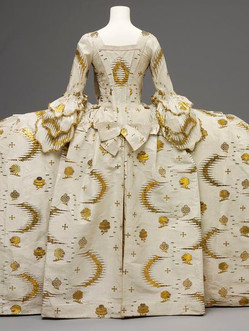2nd November 2020
- Hannah G

- Nov 14, 2020
- 3 min read
Updated: Apr 5, 2021
Design
We started the next workshop which is to create a jacket with unusual seams and darts. For initial research I looked at 1950’s and 1960’s jackets as I love the cropped, slight boxy fit. To start I created a basic jacket block from a dress block following instructions from a pattern cutting book. This was extremely helpful and lead me to do further research of tailoring/jacket books in the library to gain a better understanding of jacket construction. I really enjoy tailoring and think this is an area I would like to develop in further throughout my practice and research. After creating the basic jacket block I made a first toile, from this toile I then made alterations to create a more 1950’s/60’s shape. By shortening the length, lifting the waist and slashing into the pattern to create a slightly less fitted shape I created a second toile(By lifting the waist on a cropped jacket it makes the jacket more flattering on the figure).But unfortunately it still didn’t fit how I wanted as the shoulders were too boxy, this is because I had slashed all the way up and widen the jacket the same width all the way down. Therefore, to fix this I kept the same width at the hem and brought the shoulders back in to their original position, making a slight triangle flared shape. I also changed the sleeve of the jacket to a two-piece sleeve. Ideally I would have like the jacket to not have a peplum shape, but for this workshop we need to keep a semi fitted fit so I will keep it for now. Also from my jacket research I can see that most jackets in the 1950’s/60’s had cropped sleeves, but I'm not sure if I would like this yet so will have to decide later. I’m worried that by choosing a cropped, peplum shape the jacket may look old fashioned, but I think as long as I experiment with unusual seam and dart placements next week it will become more suitable for today's customer. The fabric could also play a big part in keeping this jacket contemporary, by using something other than wool like nylon or linen.
Research
Todays seminar was about the body and how clothes can change the way someone moves or feels, producing a certain mode of bodily demeanour. A quote by L. Negrin states that ‘it has been viewed as a purely visual phenomenon while the nature of its interaction with the body of the wearer has been overlooked. In the process, what has been ignored is that fashion is not just about the creation of a specific 'look', but is also about the comportment of the body in space.’ (Negrin 2016, p.115) An example of a garment which produces a certain bodily demeanour is the Mantua which is a dress worn to royal assemblies and balls in the 1750’s/60’s.
The corseted design made the wearer maintain a straight and graceful posture.
The wide hips restricted where and what the wearer could do. Making it difficult to manoeuvre around doorways and carriages.
The dress was made from expensive fabrics and trimmings such as gold thread, encouraging the wearer to move delicately.
The wearer may have been sewn into the garment and the extravagant size of the dress meant they would have had to be dressed and undressed.
However it became popular as an alternative to the very stiff and formal style normally worn. This style didn't require the bodice to be enforced with whalebone making it much more comfortable.
In the seminar we also spoke about Vionnet’s dresses and their connection to the body. For example, she draped geometric shapes to produce her designs which skimmed the body, creating a contradiction between the hard shapes and the curved body. These fluid shapes allowed the dresses to ‘morph to any fashionable figure’. Her design often included flower shapes which were part of the dress meaning ‘ornamentation and construction evolved in unison’. Lastly her work introduced new type of luxury which involved vast amounts of waste (bias cut creates waste). I'm interested in exploring and questioning this idea of luxury in my project proposal, so this is an area I could investigate further.
As well as ‘the body’ we learned about how to successfully gather primary and secondary research and were shown a helpful diagram which I will look back on when doing research for my project proposal. I like the idea of doing primary research which involves getting people to do something (auto-ethnography) rather than just a questionnaire. This will create a more meaningful results and is much more exciting to reflect on. For example, I could get multiple women to take photos of their favourite/most worn clothes.












Comments